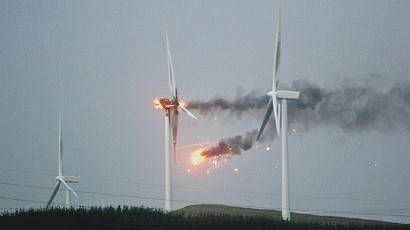The Slow Winding Down of the Windpower Idea.
December 10, 2011, 6:15 pm

photo by Stuart McMahon
Next year will mark twenty years of tax credits for the wind energy industry. The federal renewable energy production tax credit which allows producers of wind energy a 30 percent investment tax-credit or a 2.2-cents-per-kilowatt-hour production tax credit has been in force since 1992. There are more than 14,000 abandoned wind turbines in the United States. The picture above is of a very recent fire from hurricane-force gales in Scotland.
The 2.2¢ subsidy doesn’t sound like much, but it is on average 40 percent of the wholesale price of electricity. The tax cuts, according to the Treasury Dept. cost taxpayers $1.5 billion annually. A billion here, a billion there, and soon you’re talking about real money. The United States is facing $15 trillion of debt, but it has access to vast supplies of diverse sources of electricity perfectly capable of supplying our energy needs if only government gets out of the way. The subsidies are not needed, they do not work. If wind power made sense, it would not need a government subsidy in the first place.
California’s “big three” locations: Altamont Pass, Tehachapi and San Gorgonio were considered to be among the world’s best wind sites. Palm Springs issued an ordinance that required turbines to be removed from San Gorgonio, but Kern County has no such ordinance. In most cases, inoperable turbines are simply left to rust, with nobody to clean up the mess.
Altamont’s turbines have been tethered four months of every year to protect migrating birds after environmentalists filed suit. According to the Golden Gate Audubon Society, 75–110 Golden Eagles, 380 Burrowing Owls, 300 Red Tailed Hawks and 333 American Kestrels are killed by Altamont turbines every year. The same areas that are good for wind are also on migrating paths. Today, wind energy still only provides a small 2.3 percent of our electricity needs — and it is still fully subsidized. Current technology is not economically competitive. The problem is not the technology, it is the nature of wind itself. And there is some doubt if technology can ever compensate for the natural intermittence of wind.
Henk Tennekes, the Netherland’s famous engineer, former research director of the Dutch National Weather Service is an expert on wind energy. He has visited wind farms in Holland, Denmark, Germany, France and California and has never seen a wind park where all turbines were operating properly. Typically 20% of turbines are idle, out of commission, or broken down.
The Netherlands has fallen out of love with windmills. The government is cutting back on subsidy and asking customers to bear more of the cost. Offshore turbines produce more energy than land installations, but the turbines are the height of a 30-story building, The Netherlands is one of the most densely populated countries in Europe, and the turbines are unsightly and noisy. Offshore wind costs twice as much due to the higher cost of materials, more expensive drilling methods and more complex maintenance.
What keeps wind farms going are mandates enacted by many states that require a certain percentage of power to come from renewable sources— which is, essentially, another subsidy on your power bill. It’s time to end the subsidies for this fantasy of free green energy. The economics are so dismal that they are simply a squandering of our natural resources.

An abandoned wind farm in Hawaii.

No comments:
Post a Comment